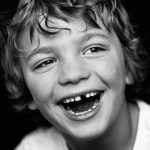|
"Have a laugh!"
Interview with journalist Barbara Kolb for the baby magazine "kiddies"
"Babies and children are photographed almost constantly these days. But to get really good pictures, you need more than just a good camera. The Hamburg photographer Ralph von Kaufmann gave "kiddies" a few useful tips in an interview.
When asked how he came to children's photography, Ralph von Kaufmann answers soberly: "Quite simply, my wife is a midwife. So the subject was obvious for me as a photographer." But when you look at his expressive black-and-white photos, you realise that there is a lot more to it than just pressing the shutter release. In the kiddies interview, he reveals how they work best.
kiddies: Why do you favour black and white photography for baby and children's photos?
Ralph: I have always had a soft spot for it and develop the images myself, using my own technique. The advantage of black and white is that I get a better handle on many problems, especially with skin tones. Babies have very different skin from adults and a wide range of skin variations. It's time-consuming, but with black and white I can intervene partially and adjust contrasts. I can't do that with colour. If a baby has very orange skin, for example, I find it very difficult to get a handle on it in colour.
kiddies: Don't people want colour pictures more nowadays?
Ralph: Since I offer black and white photos, customers come to me looking for exactly that. At the moment it's very trendy to stage the children in some way, with angel wings or something similar. For me, it's more like still-life photography. The children are draped, just not supposed to move or show any emotions. I find that boring. It's nice when something happens and movement comes into play.
kiddies: How do you prepare a photo session with a child?
Ralph: I make an appointment with the family in their private surroundings. And I almost always avoid working with flash or studio lights. My experience has shown that everyone involved is much more relaxed when there is no studio atmosphere. Flash is not possible with very small babies, who still have a very short visual radius and only perceive contrasts. In the worst case, a flash would only result in a crying baby. Such stress factors must be avoided at all costs if the baby is to remain relaxed.
kiddies: What time of day is the most convenient?
Ralph: I take photos in the morning. The children are then asleep, awake and still attentive. All that usually wears off in the afternoon.
kiddies: What do you do to make the child laugh?
Ralph: Animation is the key. Of course, it depends a lot on how old the children are. With two to four-year-olds, I use puppets and funny objects to get their attention. I also make sure that someone from the parents is always right next to me and communicates with the child. But animation is also important for babies who are a few months old, because at that age they can already laugh and grasp. Each age often requires a different tool.
kiddies: How do you manage to photograph a baby together with an older sibling?
Ralph: The older child can be involved well with toys. For a baby of about five months, however, I need someone to do the clowning, not with toys, but with speech, voice, hands and facial expressions. With a rattle, the little one would just look and his facial expressions would soon freeze. But I want to get emotions, I want the baby to cluck around, laugh and move. I only get that when mummy or daddy sits next to me and makes faces, grimaces or sings.
kiddies: So you need familiar people as "co-workers"?
Ralph: Exactly. You simply get more vivid pictures that way. The rest is actually uncomplicated because the equipment is very reduced. Before the appointment, I ask if there is a room with large windows, as I work exclusively with daylight. It is also important that the baby is not blinded by the sun. Indirect light is also softer. Since the baby often wears only a bodysuit or nothing at all, I set up a heat lamp. Otherwise, the equipment is just a white, soft gauze fabric to lay out and a light background.
kiddies: Have you ever experienced that a child just didn't want to join in?
Ralph: Yes, that happens. There are babies who have reacted very distantly to me. Especially at the age of 16 weeks, babies often have a phase in which they suddenly become strangers. I try to avoid this time now. Or when the babies have had a vaccination a week before. It doesn't make sense then, because they have to process it first. There have also been very few children who have reacted negatively and cried right from the start. Then nothing works at first. Most children, however, are open-minded and very approachable right away. In the end, it always has to do with sympathy.
kiddies: What do you do in case of rejection?
Ralph: If in doubt, you simply have to make another appointment. The parents are aware of this. You sit on the floor close to each other the whole time, because I take photos sitting or lying down in order to be at eye level with the baby. At a second meeting, everything usually works out wonderfully. Babies live in the present, they don't remember the first shooting. You simply start again from scratch.
kiddies: How long does a shoot like this take?
Ralph: On average around three hours. Unlike in a studio, where you often only have one hour, more time and the familiar surroundings at home naturally create a much more harmonious atmosphere.
kiddies: Is there an ideal age?
Ralph: In my experience, it works particularly well between the second and sixth week and from the fifth month until the four-legged stance. At this age, the children's motor skills are already well developed and there is a lot of interaction, facial expressions, gestures and emotions.
kiddies: Is there any other secret recipe?
Ralph: Do not make demands on the parents. For example, don't expect the child to be full and freshly changed - that only puts pressure on the parents. In any case, the principle of stress reduction always applies: no flash light, familiar surroundings - and breaks for breastfeeding, diapering or cuddling whenever necessary. I always give the parents the feeling that I have time. When the parents are relaxed, the baby usually is too. In other words, if the parents are stressed, I can actually pack up.
kiddies: So the parents are actually the most important thing ...
Ralph: Exactly. Children forget a bad mood quickly. Parents don't."



